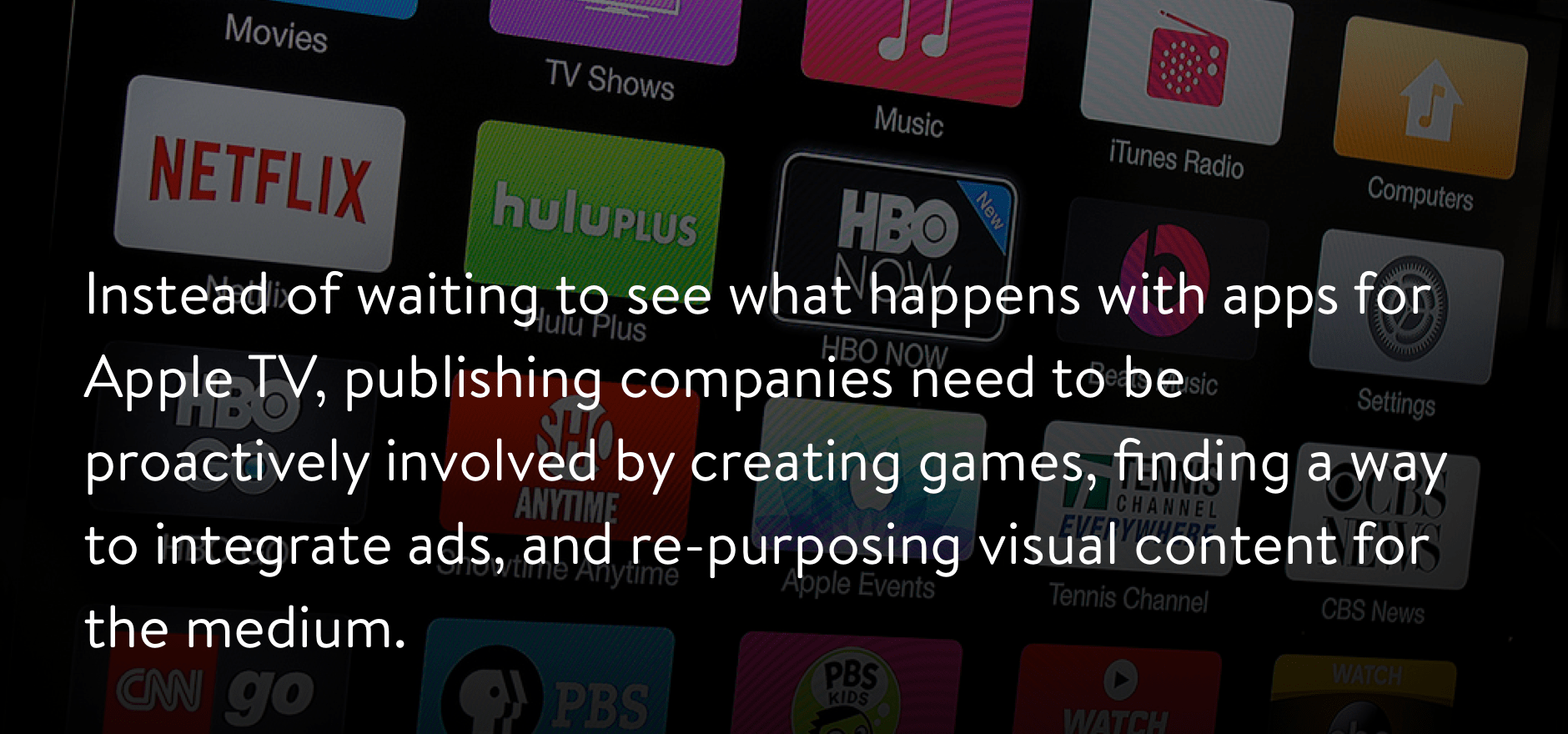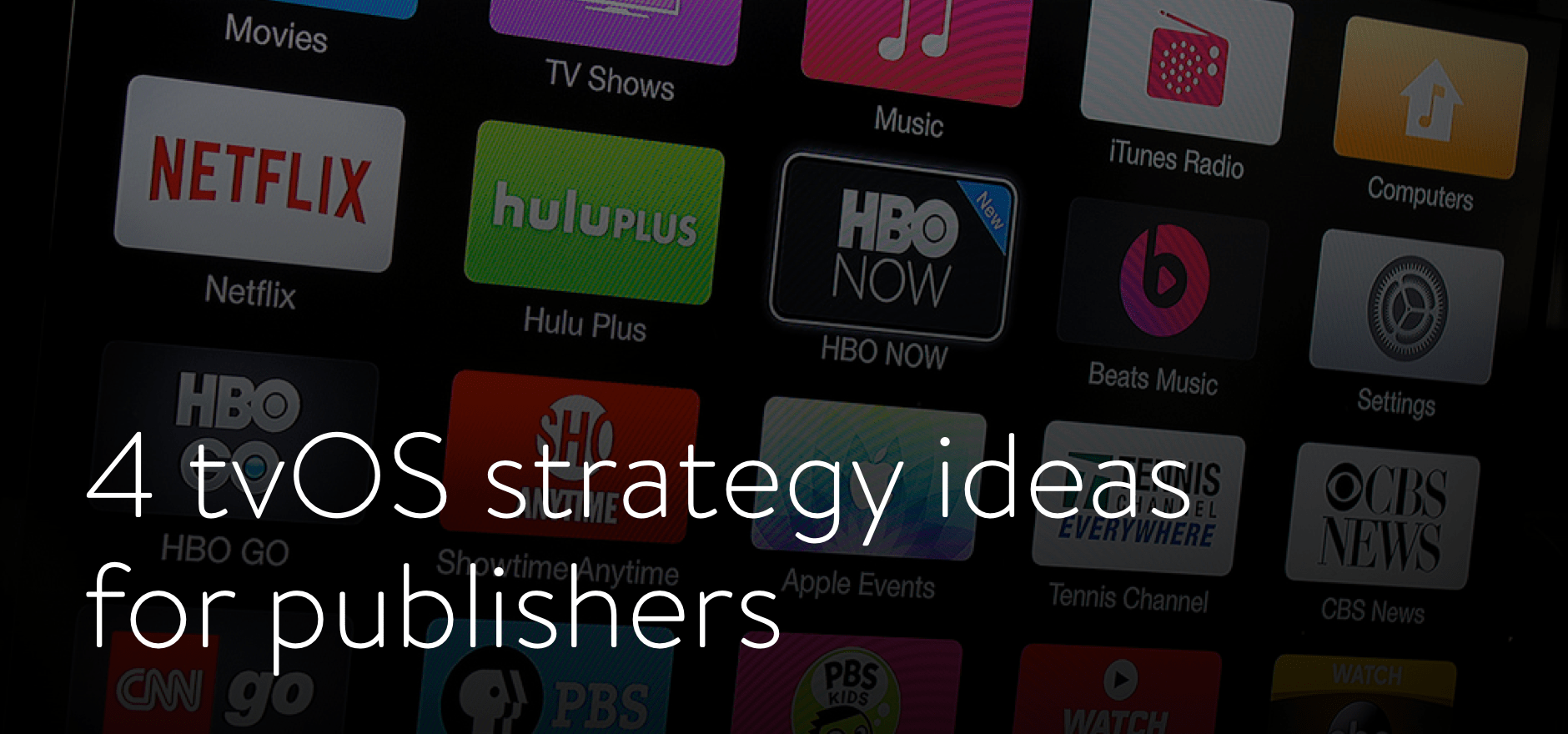
Reposted from the INMA Mobile Strategies Blog.

When Apple had its big new tech, the advent of apps for Apple TV was an interesting development and one that might have piqued media companies’ interest.
There’s a lot of “wait and see” as to whether adding apps to the traditional television experience heralds a new heyday for the medium or not. But should media companies choose to wait and observe rather than take the plunge? Or can they capitalise now on tvOS by translating their offerings into new product strategies?
We think the latter.
With more and more media companies looking to conquer the local video reporting space that was once the sole prerogative of big broadcasters (at least online – think of The McClatchy Company’s new video lab with a mandate to guide online video efforts across its newsroom network ), tvOS seems to present a wide-open opportunity to further those efforts and engage news audiences across platforms with impactful, media-rich storytelling.
As of writing this, there are already more than 1,000 apps available on tvOS and there are quite a few interesting additions to this list if you know where to look. Many go well beyond the streaming and TV-to-go apps you’d expect: games, interactive weather apps, and stock apps all make appearances – and a handful of early-adopter news media apps.
So how are media companies entering this new space?
They’re re-doubling their investment in original video production and looking at ways to aggregate video content when they’re unable to make their own. And they’re partnering with talented user experience experts and interface designers to take a revolutionary look beyond written copy.
The resulting apps, when done right, are smart, intuitive, engaging, and dynamic.
Take Newsy for instance. Already available through most video-streaming platforms, it was an easy leap to develop an app for tvOS. The E.W. Scripps Company brand billed as an “over-the-top video news service aimed at Millennials” was named one of the “best new apps” by Apple at the time of tvOS’s launch.
The company leveraged its ability to create simplistic contextual videos and curate on-demand content to provide an un-hyped take on news. But where it really won with their Apple TV app was in thoughtfully integrating an “intuitive and fun user interface” with the new Siri Remote — thinking beyond the content itself to how people interact with that content.
But what about news media publishers? With an emphasis on visual communication rather than the written word, and a gaze that moves away from click-and-zoomable content, what approach can newspapers take?
Here are a couple of ideas to keep in mind as you develop your tvOS strategy:
- Photos: Publishers who aren’t investing in original video content could think about re-purposing photo galleries, infographics, and gifs on Apple TV, supplementing photos with video ad content to create some variety.
- Editorial’s “time to shine”: Subscription pay models are ubiquitous here. Why not use the Apple TV opportunity to develop a premium long-form storytelling offering? Give your editorial department a new digital outlet for in-depth investigative reporting.
- Well-crafted long-form content with documentary video, narrative nonfiction, and compelling imagery seem a perfect fit for TV viewing with self-evident value for audiences.
- Ads: An ad software development kit (SDK) from AppLovin was just annouced for Apple TV on November 5, making it possible for the app to monetise by integrating ads with the added bonus that the ads will be targeted and measurable – metrics that traditional TV has never been able to deliver. A caveat, though, that video ads will be optimal, as static banners and interstitials won’t feel at home.
- Games: Games make up the largest cohort of apps currently available on tvOS. Publishers like The New York Times have already made mini mobile apps like Crosswords. Porting these to Apple TV may be another way publishers can test the waters of the new medium to connect the dots with their current readership and even gain new audiences.
Whatever the strategy, the old saying “content is king” prevails on Apple TV. In fact, this is true to the extent that app interfaces are essentially invisible.

Remember “the medium is the message?” On tvOS, the content is the navigation. Apple wants the tvOS experience to be highly immersive, indicating in their human interface guidelines that developers should “strive for a sense of immersion through engaging content, awe-inspiring imagery, and subtle, fluid animations.”
Developing a user experience that capitalises on this blank canvas with a well-designed app will be key to success on the platform.



